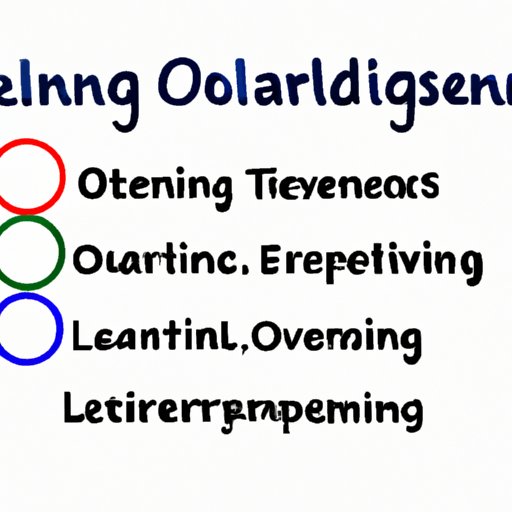I. Introduction
Learning objectives are an essential component of effective education and training programs. They serve as clear, concise, and measurable goals that guide learning and ensure successful outcomes. In this article, we will explore the concept of learning objectives, their importance, and how to identify, create, and measure them. Whether you’re an educator, trainer, or someone interested in optimizing their own learning potential, this article will provide you with a comprehensive guide to designing effective learning outcomes.
II. Defining Learning Objectives: How to Identify Clear Goals for Effective Learning
Learning objectives are statements that describe what learners should be able to do, know, or feel as a result of a particular learning experience. They provide learners and educators with clear goals to guide learning and ensure successful outcomes. To identify clear learning objectives, it is essential to define the desired results and ensure that they are specific, measurable, achievable, relevant, and time-bound (SMART). Examples of well-crafted learning objectives include:
- To identify key elements of the respiratory system and explain their function
- To analyze and evaluate the main arguments presented in a literary text
- To demonstrate effective communication skills in a professional setting
III. Why Learning Objectives are Critical to Successful Learning Outcomes
Clear learning objectives are critical to successful learning outcomes as they provide a roadmap for learners to achieve their goals. When learners and educators are clear on what they want to achieve, they are more likely to engage in learning, which leads to improved learning outcomes. Specific and measurable learning objectives also allow for clearer evaluation of the effectiveness of education and training programs. Evidence suggests that learners who have specific learning objectives perform better on assessments, learn more in less time, experience greater satisfaction with their learning, and are more likely to transfer their learning to other contexts.
IV. The Science of Learning Objectives: A Comprehensive Guide
The theoretical framework behind learning objectives includes principles of cognitive, behavioral, and social learning theories. Cognitive learning theory emphasizes the importance of information processing and memory in learning, while behavioral learning theory focuses on the acquisition of skills through observation and practice. Social learning theory emphasizes the influence of social interactions, modeling, and feedback in learning. Empirical evidence supports the use of learning objectives as they have been found to be effective in improving learner engagement, retention, and transfer of learning across domains.
V. Creating Effective Learning Objectives: A Step-by-Step Process
To create effective learning objectives, it is essential to follow a step-by-step process that includes defining the desired outcomes, identifying the target audience, selecting appropriate verbs, specifying assessment criteria, and aligning objectives with the learning content and context. Different types of learning objectives include cognitive (focused on knowledge and understanding), affective (focused on attitudes and values), and psychomotor (focused on skills and abilities) objectives. Tips for incorporating learning objectives into teaching and training include using active and engaging learning strategies, providing feedback and reinforcement, and aligning assessment criteria with learning objectives.
VI. Measuring Learning Objectives: How to Evaluate the Success of Your Training
Measuring the effectiveness of learning objectives is critical to improving education and training programs. Different methods for assessing learning outcomes include formative assessment (ongoing feedback and monitoring), summative assessment (evaluation of learning outcomes at the end of the program), and authentic assessment (evaluation of learning outcomes in real-world settings). Tips for evaluating the success of training programs include using multiple assessment methods, providing clear and timely feedback, and using assessment data to inform program improvement.
VII. Best Practices for Implementing Learning Objectives in Your Learning and Development Strategy
Learning objectives should be an integral part of designing a learning and development strategy. Best practices for incorporating learning objectives into a training plan include aligning objectives with organizational goals, involving stakeholders in the design process, providing clear expectations and guidelines, using varied and engaging instructional strategies, and regularly monitoring and adjusting learning objectives based on feedback and evaluation data.
VIII. Conclusion
In conclusion, learning objectives are a powerful tool for guiding education and training programs towards successful outcomes. By defining clear and measurable goals, learners and educators can work together to achieve meaningful and impactful learning experiences. Whether you’re an educator, trainer, or someone interested in optimizing your own learning potential, learning objectives can help you achieve your goals and improve your outcomes.
Key takeaways:
- Learning objectives provide clear and concise goals for effective learning
- Specific and measurable learning objectives lead to successful learning outcomes
- Learning objectives are grounded in cognitive, behavioral, and social learning theories
- Effective learning objectives follow a step-by-step process and align with the learning context and content
- Evaluating learning outcomes and adjusting learning objectives are best practices for successful training programs
Unlock the potential of your learning and development strategy with effective learning objectives today.
